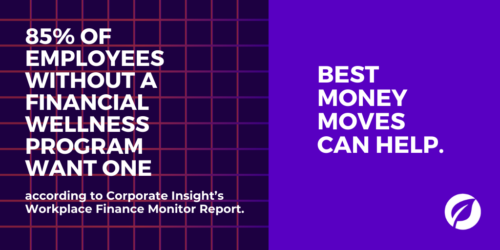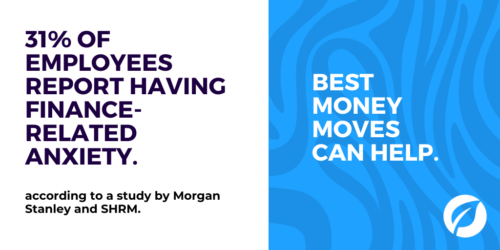
Top 5 Financial Wellness Program Features for 2022
Financial wellness is 2022’s must-have employee benefit. According to Corporate Insight’s Workplace Finance Monitor Report, 85% of employees without a financial wellness program want one.
However, not all financial wellness programs are created equal. The most successful programs include features tailored to the employees that use them.
Here are 5 top program features for your 2022 financial wellness platform.

1. Look for financial wellness programs that utilize a holistic approach to money.
Each one of your employees has to navigate their financial health ⸺ that’s one of the top appeals of offering financial wellness benefits. However the money management needs of a veteran employee about to retire are going to look very different than those of a recent grad dealing with credit card debt.
So, financial wellness programs are most useful to employees if they can encompass all facets of financial health. From paying down immediate debt to reaching long-term goals, an all-encompassing program will grow with your employees and offer something for those at any stage. Best Money Moves offers solutions for users from any financial background. Whether it’s basic budgeting, complex debt repayment, funding an education or planning for the future, the platform offers something that all employees can use.
2. Give your employees professional, personalized advice.
While it’s important for financial wellness platforms to cover the financial spectrum, an effective program will also include specialty features that pertain to each employee’s unique situation. Offering specialized, professional advice can also help engage demographics otherwise less likely to use financial benefits. Female participants and those with lower household income are less likely to enroll in financial wellness programs and are more likely to reach out to a friend for financial advice. Best Money Moves takes in user data to highlight stress points and uses them to suggest resources. The platform helps employees connect to other, personalized services from our comprehensive list of verified partners.
3. Consider platforms with actionable resources.
The Workplace Monitor Report also found that, among employees who had access to financial wellness programs, financial goal tracking and budgeting resources were amongst the highest rated features. The Best Money Moves Budget tool is a detailed feature that allows users to input their income, expenses and savings to give a comprehensive breakdown of how to spend your money. Users enter information about how they currently allocate their budget and Best Money Moves helps highlight areas of success and concern. The platform also includes intuitive calculators and a savings and debt tracker that allow employees to monitor long-term financial progress. Best Money Moves also offers unique user Journeys that take employees step-by-step through large financial decisions such as buying a home or a car.
4. Engage your employees with easy to use platforms.
For your employees to get what they need out of a financial wellness program, those programs need to be easy-to-use. That’s why Best Money Moves focuses on providing financial education for employees of all experience levels. Users of any financial experience can find what they need in a library of over 800 articles, videos and webinars. Even a 10-minute session on the site on desktop or mobile can get users started on their financial journey.
5. Find financial wellness programs that keep track of your team’s progress.
An integral part of effective financial wellness programs involve showing employees the progress they’ve made on their personal finance goals. Keeping these goals in mind allows employees to find long-term solutions to their problems, instead of quick fixes. Best Money Moves provides several features that help users track their financial journey over the course of months, or even years. Plus, Best Money Moves is designed to provide employers with anonymous feedback about which financial challenges their employees are struggling with most. In this way, employers can offer other benefits and solutions targeted to their team’s unique pain points.
To learn more about Best Money Moves Financial Wellness Platform, let’s schedule a call. Contact us and we’ll reach out to you soon.






